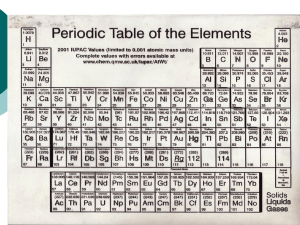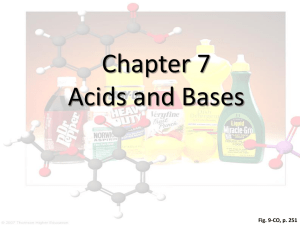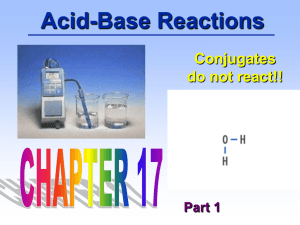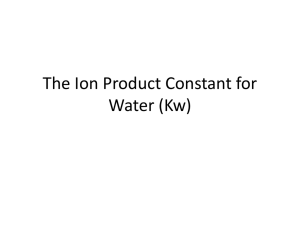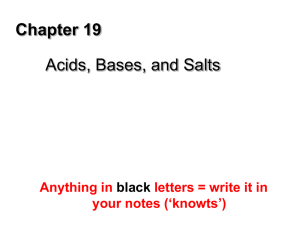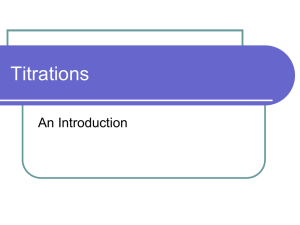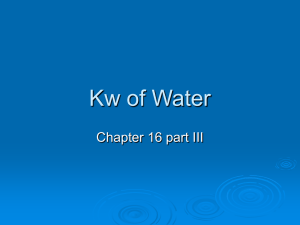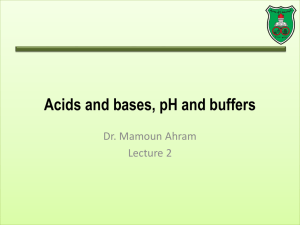11 - Acid/Base Properties of Salts
advertisement
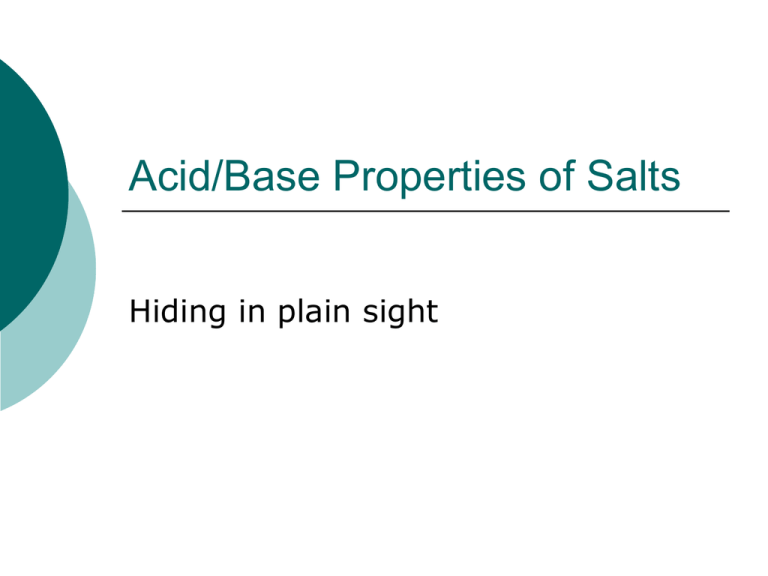
Acid/Base Properties of Salts Hiding in plain sight Recognizing Bases Sometimes it seems that all acids and bases are labeled with H+ or OHRemember that a base is ANYTHING that can accept a proton The salt formed by the dissociation of an acid is the “conjugate base” of the acid. This must mean that the salt is a base, whether it has an OH- or not. Pick a salt, any salt How about sodium acetate, NaOAc? An excellent choice. Sodium acetate is an ionic solid. Ionic solids dissociate in aqueous solution Aqueous NaOAc will exist as anions and cations. NaOAc in aqueous solution NaOAc (aq) Na+(aq) + OAc-(aq) So what can we say about Na+ and OAc- in aqueous solution? We need to think “backwards”. How did NaOAc get the Na+ in the first place? (Or, more accurately, what is one way it could have gotten it?) Salts are products of acid/base reactions You might recall that the reaction of an acid and a base yields a salt and water: NaOH + HOAc H2O + NaOAc Keep in mind, this is the “net reaction”, it doesn’t give any detailed information on mechanisms. A more detailed reaction Think of a titration: NaOH (aq) + HOAc (aq) H2O (l) + NaOAc (aq) But what are NaOH (aq) and HOAc (aq)? Acid (and Base) Dissociation Reactions NaOH(aq) + H2O(l) H-OH (l) + OH-(aq) + Na+(aq) Kb Or: NaOH Na+(aq) + OH-(aq) OH- (aq) + H2O(l) H-OH (l) + OH-(aq) HOAc Kb + + H O H O + OAc (aq) 2 (l) 3 (aq) (aq) Ka Putting it all together… NaOAc (aq) Na+(aq) + OAc-(aq) NaOH(aq) + H2O(l) OH-(aq) + Na+(aq) + H-OH HOAc + + H O H O + OAc (aq) 2 (l) 3 (aq) (aq) (l) Putting it all together… NaOAc (aq) Na+(aq) + OAc-(aq) NaOH(aq) + H2O(l) OH-(aq) + Base HOAc Base acid (aq) Na+(aq) + H-OH (l) conjugate conjugate base acid + H2O(l) H3O+(aq) + acid OAc-(aq) conjugate conjugate acid base In short… We have the conjugate acid (Na+) of a base (NaOH), and the conjugate base (OAc-) of an acid (HOAc). You can always tell… Take the anion and add an H+, that’ll tell you what acid the anion “came from”. Take the cation and either add an OH- or take away an H+ and that will tell you what base the cation came from. Ignore anything strong – it won’t, it CAN’T go back!!! Kb becomes Ka as Ka becomes Kb NaOAc (aq) Na+(aq) + OAc-(aq) Na+(aq) + 2 H2O (l) NaOH(aq) + H3O+ (aq) (or, if you prefer) Na+(aq) + H2O (l) NaOH(aq) + H+ (aq) Ka=Kw/Kb OAc-(aq) + H2O(l) OH-(aq) + HOAc (aq) Kb=Kw/Ka But one is strong and the other weak. NaOH(aq) + H2O(l) H-OH Na+(aq) + H2O HOAc (l) (l) + OH-(aq) + Na+(aq) Kb= NaOH(aq) + H+ (aq) Ka=Kw/Kb = 0 + -5 + H O H O + OAc K =1.8x10 (aq) 2 (l) 3 (aq) (aq) a OAc-(aq) + H2O(l) OH-(aq) + HOAc (aq) Kb=Kw/Ka Kb = 10-14/1.8x10-5=5.56x10-10 Net Result NaOAc gives rise to a single equilibrium reaction that must be considered: OAc-(aq) + H2O(l) OH-(aq) + HOAc Kb=5.56x10-10 The salt is a base!!!! (aq) Sample problem What is the pH of a 0.100 M solution of NaOAc? What do we need? Balanced equation What is it? NaOAc (aq) Na+ (aq) + OAc- (aq) Where does Na+ “come from”? NaOH Where does the OAc- (aq) “come from”? HOAc NaOAc (aq) Na+ (aq) + OAc- (aq) NaOH Strong Base HOAc Weak Acid OAc-(aq) + H2O (l) HOAc (aq) + OH-(aq) OAc-(aq) + H2O I 0.100 M C –x E 0.100-x - (l) HOAc 0 +x x (aq) + OH-(aq) 0 +x x Now all we need is K! Kb(OAc-) = Kw/Ka(HOAc) = 1x10-14/1.8x10-5 = 5.56x10-10 OAc-(aq) + H2O (l) HOAc (aq) + OH-(aq) OAc-(aq) + H2O (l) HOAc (aq) + OH- (aq) I 0.100 M C –x E 0.100-x - 0 +x x 0 +x x Kb = 5.56x10-10 = [OH-][HOAc] [OAc-] OAc-(aq) + H2O (l) HOAc (aq) + OH-(aq) Kb = 5.56x10-10 = [OH-][HOAc] [OAc-] 5.56x10-10 = x*x 0.100-x Assume x<<0.1 5.56x10-11 = x2 7.45x10-6 = x, GOOD assumption OAc-(aq) + H2O (l) HOAc (aq) + OH-(aq) OAc-(aq) + H2O (l) HOAc (aq) + OH-(aq) I 0.100 M 0 0 C –7.45x10-6 - + 7.45x10-6 + 7.45x10-6 E 0.100 7.45x10-6 7.45x10-6 pOH = -log (7.45x10-6) = 5.12 pH = 14 – 5.12 = 8.88 More fun with salts… What can we say about: NaCl? NaCl = Na+ + Cl- It came from… Cation + OH- = NaOH Anion + H+ = HCl So…. If you can’t find Ka … …maybe it’s a strong acid. Or if you do find it, it is HUGE! Strong acids: HCl Ka ~106 HBr HI HNO3 HClO4 H2SO4 (diprotic – more on this next week) If you can’t find a Kb… …maybe it’s a strong base. (Or Kb is huge.) List of strong bases: LiOH NaOH Kb~108 KOH Sr(OH)2 Ca(OH)2 Ba(OH)2 What kind of acid/base is it? NaOH? STRONG base HCl? STRONG acid The salt is… NEUTRAL we “ignore both” More fun with salts… What can we say about: KCl Came from: KOH and HCl Also neutral! More fun with salts… What can we say about: Ca(OAc)2 Ca(OAc)2 → Ca2+ + 2 OAcIt came from: Ca(OH)2 and HOAc Only the HOAc matters, it’s weak. More fun with salts… What can we say about: NH4Cl It came from? NH3 (or NH4OH) and HCl More fun with salts… What can we say about: NH4OAc It came from: NH3 and HOAc BOTH WEAK!!! If they are both weak… Look at the K. Biggest K wins. Although for NH4OAc.. Ka(NH3) = Kw = 1.00x10-14 = 5.68x10-10 Kb(NH3) 1.76x10-5 Kb(HOAc) = Kw = 1.00x10-14 = 5.59x10-10 Ka(HOAc) 1.79x10-5 NH4OAc ends up being neutral! If they don’t cancel…??? We won’t worry about the exact calculation (you’d need to do both simultaneous equilibria), but you can tell whether it is acidic or basic: NH4IO3 (ammonium iodate) It comes from: NH3 and HIO3 Kb(NH3) = 1.76x10-5 Ka(HIO3) = 1.7x10-1 HIO3 is a better acid than NH3 is a base. Which means that NH4+ is a better acid than IO3- is a base. If they don’t cancel…??? NH4IO3 (ammonium iodate) It comes from: NH3 and HIO3 Kb(NH3) = 1.76x10-5 Ka(HIO3) = 1.7x10-1 HIO3 is a better acid than NH3 is a base. Which means that NH4+ is a better acid than IO3- is a base. A solution of NH4IO3 would be acidic. Another little problem What is the pH of a 0.250 M solution of Ca(IO3)2? Where do we start? Split the salt into ions Ca(IO3)2 Ca2+ + 2 IO3Where did the ions come from? Ca(OH)2 and HIO3 Which are…? Ca(OH)2 is strong HIO3 is weak. Ignore the Ca2+ Now, we need to… Write a balanced equation! IO3-(aq) + H2O (l) HIO3(aq) + OH-(aq) Once I have a balanced equation: ICE chart K equation ICE ICE BABY ICE ICE IO3-(aq) + H2O (l) HIO3(aq) + OH-(aq) - I C E -x - What else? +x +x Another little problem What is the pH of a 0.250 M solution of Ca(IO3)2? ICE ICE BABY ICE ICE IO3-(aq) + H2O (l) HIO3(aq) + OH-(aq) I 0.500 M - 0 0 C -x - +x +x E 0.500-x - x x Now K K = [HIO3][OH-] [IO3-] This is the Kb of IO3 Kb(IO3) = Kw/Ka Ka(HIO3) = 1.7x10-1 Kb = 1x10-14/1.7x10-1 = 5.88x10-14 5.88x10-14 = [HIO3][OH-] [IO3-] 5.88x10-14 = [x][x] [0.5-x] How do we solve this? Assume x<<0.5 5.88x10-14 = [x][x] = [x][x] [0.5-x] 0.5 2.941x10-14 = x2 1.715x10-7 = x Good assumption? YES, MA’AM! ICE ICE BABY ICE ICE IO3-(aq) + H2O (l) HIO3(aq) + OH-(aq) I 0.500 M - 0 C - 1.715x10-7 - + + 1.715x10-7 1.715x10-7 E 0.500 - 1.715x10-7 1.715x10-7 How do we finish? 0 Another little problem What is the pH of a 0.250 M solution of Ca(IO3)2? [OH-] = 1.715x10-7 pOH = - log (1.715x10-7) = 6.77 pH = 14 – pOH = 14 – 6.77 = 7.23 Make sense? You bet! Strongish acid (HIO3), very weak conjugate. Almost neutral.
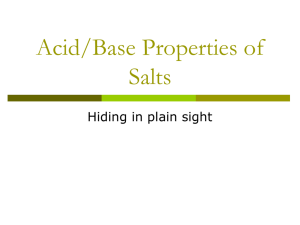

![pH = - log [H + ]](http://s2.studylib.net/store/data/005622524_1-002df1ea50d2a849b15deb604928664e-300x300.png)
